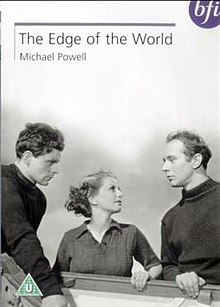The Edge of the World
| The Edge of the World | |
|---|---|

DVD cover
|
|
| Directed by | Michael Powell |
| Produced by | Joe Rock |
| Written by | Michael Powell |
| Starring |
John Laurie Belle Chrystall Eric Berry Finlay Currie Niall MacGinnis |
| Music by | Lambert Williamson (uncredited) |
| Cinematography |
Monty Berman Skeets Kelly Ernest Palmer |
| Edited by | Derek N. Twist |
| Distributed by | British Independent Exhibitors |
|
Release date
|
6 July 1937 (UK) |
|
Running time
|
81 minutes |
| Country | United Kingdom |
| Language | English |
| Budget | £20,000 (est.) |
| Author | Michael Powell |
|---|---|
| Country | United Kingdom |
| Language | English |
| Genre | Non-Fiction |
| Publisher | Faber & Faber |
|
Publication date
|
1938, 1990 |
| Media type | |
| ISBN |
The Edge of the World is a 1937 British film directed by Michael Powell, about the evacuation of the Scottish archipelago of St Kilda. It was Powell's first major project. The title is a reference to the phrase Ultima Thule, coined by Virgil (Georgics 1:30).
The film is the story of the de-population of one of the isolated, outer islands of Scotland as, one by one, the younger generation leaves for the greater opportunities offered by the mainland, making it harder to follow the old ways of life there.
Robbie Manson (Eric Berry) wants to leave the island and explore the wider world. Robbie's friend Andrew Gray (Niall MacGinnis) and his sister, Ruth Manson (Belle Chrystall) are sweethearts and are quite willing to stay. Of their fathers, Peter Manson (John Laurie) is determined to stay while James Gray (Finlay Currie) suspects that their way of life cannot last much longer.
But if Robbie leaves, that will make it harder for the others because there will be one less young man to help with the fishing and the crofting.
Powell had been making studio based 'quota quickies' for some years but wanted to make a film about the depopulation of the Scottish islands ever since seeing a newspaper article about the evacuation of St Kilda some years before.
He wasn't allowed to film on St Kilda but found another suitable island in Foula in the Shetland Islands to the north of Scotland.
Powell gathered together a cast and crew who were willing to take part in an expedition to what, before the air service that now exists, was a very isolated part of the UK. They had to stay there for quite a few months and finished up with a film which not only told the story he wanted but also captured the raw natural beauty of the location.
Powell wrote a book about his experience making the film: raising the initial funding, trying and failing to make the film on St Kilda, then realising that Foula could be used instead. He detailed how the cast and crew were selected and how they lived and worked on the island at a time when there were no flights there, only occasional radio communication. They even had to build their own accommodations.
...
Wikipedia
